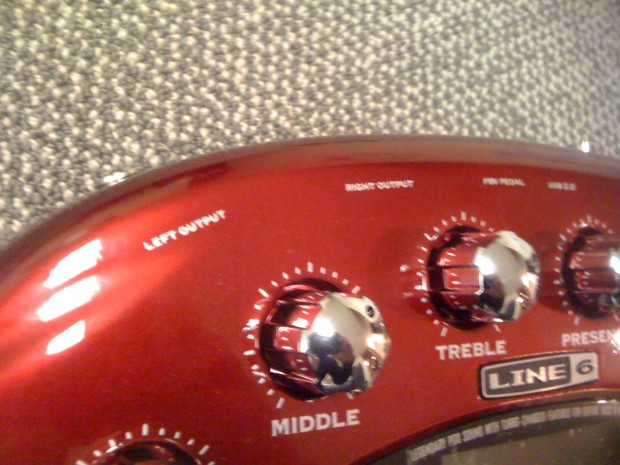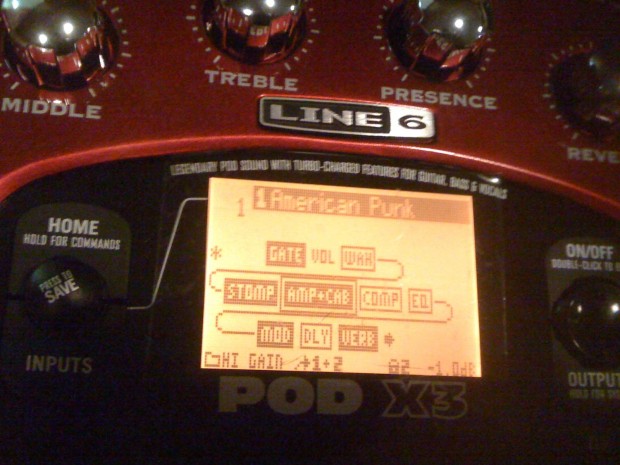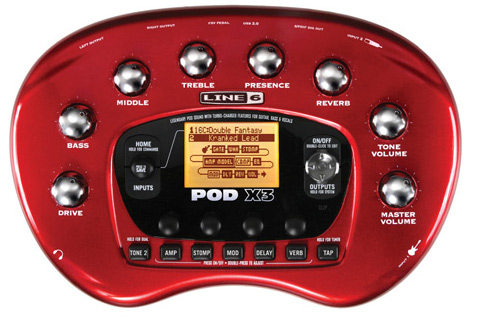As immature as it sounds, I was originally suspect of Line 6 products because I did not like the name of their Variax guitar line. (Whew, glad that’s off my chest). But while working on an audio project a while back, I picked up a Line 6 TonePort UX2 amp simulator/tone modeler in order to record some guitar parts. I bought the TonePort because it was cheaper than its competition and because it had cool, old-school analog meters. Not expecting much, I was quite impressed with the versatility of instrument tones and ease of use. I was eager to try it in a “live” situation, but the TonePort is really more of a recording device since it requires a computer to be present for its UI. I really didn’t want to lug my laptop out to a gig and set it on top of my amp—that’s just not very “rock and roll”. Besides, I would have inevitably spilled beer all over it and the MacBookPro only gets a 5 out of 100 on the Beer Spillage Scale (read on for more detail on the Beer Spillage Scale). Anyway, while contemplating this, a little research pointed me instead to the Line 6 POD X3 which has pretty much the same functionality as the TonePort, except the UI is built in and it can operate as a standalone unit. I therefore figured it would be my chance to hear the tones coming through an amp without looking like a douche. So how does it sound?
The bottom line is that it can sound really great!
Actually, I can sum up the Line 6 POD X3 this way; in a live situation, it won’t make a great amplifier sound any better than that amplifier sounds on it’s own, but it sure can make a piece of junk sound like a whole new amp (especially if the junker is a tube amp). When it comes to distorted effects to layer on top of an existing amp tone, it is very functional. And for computer-based recording, it’s awesome! It makes it easy to record simple demos or even full-on, layered scores.
I therefore like to break its use into two categories: use in a live sound situation and use as a recording device. But first I’ll let you know my thoughts on the hardware design, usability and tone. Then I will describe how it worked for me live and for recording.
Hardware Design
 In general, the POD X3 hardware design is solid. The device mostly feels like a professional piece of sound equipment. The die-cast metal outer shell feels good and “dropable”. The main knobs are large and solid and never seem loose. All the labels are descriptive and readable in low light. There are a few smaller knobs and buttons that unfortuantely have a toy-like feel but they are still passable. It also weighs enough to stay anchored on top of an amp or stationary on the floor and the rubber feet on the bottom really “grip” and keep the unit from moving about. Also, I would give the POD X3 a 75 out of 100 on the Beer Spillage Scale, meaning that if you spilled beer all over it, there is a 75% chance the device would survive the event.
In general, the POD X3 hardware design is solid. The device mostly feels like a professional piece of sound equipment. The die-cast metal outer shell feels good and “dropable”. The main knobs are large and solid and never seem loose. All the labels are descriptive and readable in low light. There are a few smaller knobs and buttons that unfortuantely have a toy-like feel but they are still passable. It also weighs enough to stay anchored on top of an amp or stationary on the floor and the rubber feet on the bottom really “grip” and keep the unit from moving about. Also, I would give the POD X3 a 75 out of 100 on the Beer Spillage Scale, meaning that if you spilled beer all over it, there is a 75% chance the device would survive the event.
This is important. I’m serious.
The center “On/Off” and “Home” buttons are the only real achillles heel where beer could get to the inside of the unit. It is comforting to know this as you line up an evening’s worth of pints next to it on the floor.
Also, the device is fairly small and self contained. Perfect for practice yet capable for live use. The distinctive metalic-red coloring of the body is nice too.
Usability
My first test to define greatness is usually this: “If I turn the thing on and, without reading the manual, can figure out how to master it in about 5 minutes…it’s a brilliant device”. (See iPhone)
The POD X3 is no iPhone. I was forced to read the manual and believe me, to read the manual is a sign of weakness. Alas, I cracked. The manual helped though and cleared up most of the confusion for me but the the POD X3 is fairly complex and I would be lying if I said I still understand all of it’s functionality. I will describe the basic setup.
 The device has 2 zones of interaction: The outer ring of larger “amp-like” knobs and the inner ring which houses the screen and smaller controls and buttons. It’s probably an over-simplification to say that the outer ring is like the normal power amp section of an amplifier and the the inner ring is like the pre amp section, but that is how I imagine it. When you boot up the POD X3, the first thing you see on the monochrome, orange backlit screen in the center is the depiction of the basic signal chain, effects and virtual hardware components you can place in that chain to model your instrument tone. There are rows of buttons and knobs just below the screen. The soft, rubbery buttons correspond to the virtual signal chain (double click to get to a virtual device’s properties) and the small knobs edit those properties.
The device has 2 zones of interaction: The outer ring of larger “amp-like” knobs and the inner ring which houses the screen and smaller controls and buttons. It’s probably an over-simplification to say that the outer ring is like the normal power amp section of an amplifier and the the inner ring is like the pre amp section, but that is how I imagine it. When you boot up the POD X3, the first thing you see on the monochrome, orange backlit screen in the center is the depiction of the basic signal chain, effects and virtual hardware components you can place in that chain to model your instrument tone. There are rows of buttons and knobs just below the screen. The soft, rubbery buttons correspond to the virtual signal chain (double click to get to a virtual device’s properties) and the small knobs edit those properties.
 The good news is that even though setting up a guitar tone on the POD X3 can be a little confusing using the on-board controls, the engineers at Line 6 are pretty clever and made the device also configureable with their desktop software called GearBox. You take a USB cable and connect the POD X3 to your laptop or desktop machine running GearBox and Voilà—you can easily set all your presets through the much nicer computer interface. And truly that would be my recommendation; set up all your presets from the computer interface and save them to the device. The beauty of the POD X3 is this design model: it can be controlled by a computer but it also has everything you need on-board for in-the-field edits.
The good news is that even though setting up a guitar tone on the POD X3 can be a little confusing using the on-board controls, the engineers at Line 6 are pretty clever and made the device also configureable with their desktop software called GearBox. You take a USB cable and connect the POD X3 to your laptop or desktop machine running GearBox and Voilà—you can easily set all your presets through the much nicer computer interface. And truly that would be my recommendation; set up all your presets from the computer interface and save them to the device. The beauty of the POD X3 is this design model: it can be controlled by a computer but it also has everything you need on-board for in-the-field edits.
Tone
Besides writing for CrunchGear and doing mobile strategy work at the day gig, I am also one of the touring upright bassists for Nashville Honkey-tonkers Bucktown Kickback. I can safely say that in the 25,000+ van miles I have logged touring around the U.S. with that group, I have seen every conceivable live sound situation. From “hey, the sound guy called in sick tonight and you guys are on your own” to “would you like 3 or 4 monitor mixes tonight sir, oh and shrimp cocktail or caviar?” The reality for a touring musician is anything but predictable when it comes to live sound and it is for this reason that I’m really not that picky when it comes to instrument/amplifier setup. I’m not a vintage gear whore nor a purist requiring the exact same set up every night. I am fairly pragmatic and can usually roll with the punches. More than anything I search for warmth of tone when possible. Despite this intended flexibility, I’ll admit I’ve never been too keen on effects processors (these days they call them “modelers”). I always thought they sounded “wanky” and tried to stay away from them. Well, a lot has changed in the 15 years since I last used one.
Line 6 has extensively sampled many, many classic amps, cabinets and mic setups for their products and, as I noted earlier, have done so with great results. This is evident on the POD X3 as it lets you mix and match classic/modern amp and cabinet sounds for custom instrument tone and it replicates these well for recording and studio use. Their website accurately and somewhat overzealously describes the POD X3’s capability this way:
The desktop-friendly POD® X3 represents the exciting evolution of the classic bean-shaped digital guitar amp modeler, with an expanded array of 78 guitar amps, from high-wattage heavyweights to boutique beauties and vintage treasures.
Guitar amp models are just the beginning: With 24 guitar cabs, 98 stompbox and studio effects, 28 bass amps, 22 bass cabs and six vocal preamps – POD X3 comes complete with the all-around sonic firepower of a top-tier major-label studio, ready to tackle guitar, bass vocals and beyond. What’s more, its larger LCD and smart new editing workflow pages make it easier than ever to find, tweak and save tones.
Live Rehearsal
I tested the device on two different physical amplifiers: A 300 Watt Mesa Boogie Walkabout Scout bass amp and a 1965 30 Watt Univox 305R guitar amp. The Mesa is a great amp. The Univox…well, lets just say it’s unique. (Actually, it’s not necessarily a bad amp, but is just very one dimensional in tone). It will howl in its own distinctive way, but that’s all it’s got. I actually liked how the POD X3 colored that amp’s tone quite a bit.
When testing the POD X3 with an Epiphone Alleykat 6 string guitar through the Walkabout, it first seemed to lack a bit of the warmth that the Mesa normally has on it’s own, but I later found out that I didn’t have it dialed in very well. You need to make sure you set the outputs to preamp and not studio to get the cleanest “live” tones. Despite the headroom the Walkabout has, I was able to simulate that “amplifier-breaking-up” sound pretty well with a couple of tweaks to the presets. With the Univox, I think I achieved a nice ballsy guitar blast as well. I was impressed with results. I wondered if the fact that the Univox is an all tube amp, helped “humanize” the digitalness of the POD a bit, but I didn’t dive much deeper than that because I liked the sounds, especially the American Punk tone model.
BUT…I’m a bassist, not a guitarist, so naturally when I ran an American P-Bass through it, I found the bass tones a little thinner than the guitar tones. Maybe Line 6 spent more time on their Guitar models? Or maybe this because I simply have more experience with bass tones and I just don’t know any better when it comes to guitar? I tend to think the later is true because I did read reviews by some guitarists out there on various message boards citing that the POD X3 had too high of a gain or was “metally” or was lacking nuance. It might just be a perception issue.
However, please don’t misunderstand me though because while I said the bass tones were a little thinner than my regular amp, the POD still sounded really, really good and in fact for some styles of music was perfect. Many of the distorted bass tones were cool and perfect for mimicking a fuzzed out hardcore sound. So in the end, it has a lot of usefulness and could be part of the traveling toolset for any guitarist or bassist.
Also, it can be used as a Mic pre-amp for vocals, but I don’t currently have a mic that would do it justice, so I declined to test that out much.
Recording
Since I had already done quite a bit of recording straight to my computer using the TonePort, I found that the POD X3 behaved identically. Using it with GearBox was a sinch to port directly to GarageBand. As a recording device, I read that it will work with Ableton, GarageBand, Logic and Cubase. Interestingly though, Line 6 products will not work with ProTools.
Other Notable Features
One cool thing about the POD X3 is that it has two channels. So it can operate like a traditional amp where you could set one channel to a clean tone and the other channel to a distorted tone for the classic SOFT/LOUD sound. It has a jack in the back for a footswitch, however Line 6 did not send a foot switch, so I can’t really tell you how well that works. While messing with the channels though, I kept thinking to myself “what if I could use this thing as a ‘splitter’ and send one tone to one amp and the other tone to a second amp, simultaneously”? Gadzooks—you can! You can send both channels to different amps or conversely, you can send both channels to the same amp and mix between them without any loss of signal strength. That is a pretty neat feature. There is a nice little demo at line6.com that illustrates this.
Additionally, the Line 6 website is a pretty powerful resource. There are some fairly active forums for technical answers and their administrators seem attentive and helpful. Also, they have a unique section of their site called CustomTone. This section is where users can upload and share tone preset files they have created with various Line 6 products. These “tones” are exported as an info file and can be downloaded and used by other users. These services, coupled with their Line 6 Monkey desktop application (for updating drivers and tone packages) make for an interesting, collaborative and fun way to approach playing guitar or bass—especially for gadget minded folks out there.
The Real Live Test
I did decide to put the POD X3 to the real test and take it to a gig intending to run it as my sole preamp for my bass cabinet that evening. Unfortunately, it was causing my power amp to create a hum in the PA system. I was unable to eliminate the noise during the allotted sound-check time slot and was forced to revert to my regular amplifier. I plan on giving it another test soon because the reason for the hum could have been related to a specific issue with that single PA system and not necessarily a problem with the POD X3.
What Is It Missing?
I was unable to figure out a way to truly “bypass” the POD X3 while still keeping it in the regular amp signal chain and therefore could not get it to act like a normal effects pedal, which I thought was a bummer. It might be possible to run it through an amplifier effects loop, but I did not give that a try.
Bottom Line
The POD X3 is a fine little amp simulator and works great in the studio for both simple and complex recording projects. It’s built well and has many unique features. I had enough issues with it as a “live amp” solution that, at this point, I probably would not rely on it as my sole rig at a gig. It is small enough that I would still want to take it with me to every gig just to have it on hand, and that is worth noting. I don’t think the goal of the POD X3 is to act like a modular effects processor for sporadic use, but rather is built to operate more like a complete amp replacement technology. That is a bold concept, however I still think if it could be truly bypassed and therefore capable of acting as either an effects processor OR amp modeler/simulator, that it would be more useful and find its way into more setups. But that’s just my wishlist for it. While purists may not like the sounds or the style of the POD X3, it is still a very convenient and functional tool for achieving some great digital instrument tones, and at $399 is a cheaper solution than buying multiple physical amplifiers. I can see where it could be used by working studio professionals or home prosumers for many kinds of audio projects.
